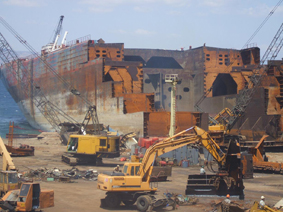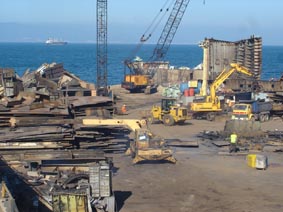|
 Ship dismantling and recycling is by definition an environmentally
friendly activity contributing to sustainable development by reducing depletion of the quality and quantity of natural resources.
The benefit to the environment
from ship dismantling and recycling is twofold; on the one
hand it removes older vessels that would otherwise be
left abandoned, polluting the seas. On
the other hand it provides reusable and recyclable materials
and hence achieves a far better environmental performance
given the production energy efficiency,
the reduction in emissions from subsequent processing,
and the preservation of non-renewable resources. The increased awareness of sustainable development gives environmentally
credible companies, such as LEYAL, a competitive advantage.
Ship dismantling and recycling is by definition an environmentally
friendly activity contributing to sustainable development by reducing depletion of the quality and quantity of natural resources.
The benefit to the environment
from ship dismantling and recycling is twofold; on the one
hand it removes older vessels that would otherwise be
left abandoned, polluting the seas. On
the other hand it provides reusable and recyclable materials
and hence achieves a far better environmental performance
given the production energy efficiency,
the reduction in emissions from subsequent processing,
and the preservation of non-renewable resources. The increased awareness of sustainable development gives environmentally
credible companies, such as LEYAL, a competitive advantage.
 LEYAL employs a combination of afloat & landing dismantling methodology, with
on land cutting taking place on concrete impermeable floor
with appropriate drainage and underground effluent collection.
Cutting is done with a combination of torch cutting (oxy-LPG)
and mechanical cutting (mobile shear).
A wide variety of facilities are based on site, such
as the Environmental Management Centre (EMC), worker
accommodation quarters, infirmary, and both open-air
and specialized covered storage areas.
LEYAL employs a combination of afloat & landing dismantling methodology, with
on land cutting taking place on concrete impermeable floor
with appropriate drainage and underground effluent collection.
Cutting is done with a combination of torch cutting (oxy-LPG)
and mechanical cutting (mobile shear).
A wide variety of facilities are based on site, such
as the Environmental Management Centre (EMC), worker
accommodation quarters, infirmary, and both open-air
and specialized covered storage areas.
Once LEYAL is contracted for the recycling of a vessel, and prior
to the vessel's arrival, both the local authorities and the EMC
are notified. Drawing from its wide knowledge base and longstanding
experience, along with the information provided by the shipowner and also drawn during the
vessel's pre-demolition inspection, the Company is in a position to establish a specific and viable ship
recycling plan, also addressing issues such as waste removal and disposal.
Upon arrival the vessel is secured at the yard and
it is checked for radiation readings and gas free
condition. After the local authorities issue
the necessary permissions, a team of certified experts
identifies hazardous substances and plans their removal and disposal.
Following the pre-cleaning of the vessel the main dismantling operations commence.
The dismantling of a vessel starts from the pre-cleaning of the superstructure
and the dismantling of forward sections. Heavy lift cranes remove big sections
of the vessel and place them in specialized concrete-paved zones, where the
secondary cutting and additional material separation takes place. The sections are
reduced to marketable sizes using a cobination of cold and hot cutting methods (LEYAL is the only ship recycling
facility in Turkey to employ large scale mobile hydraulic shears) and categorized based
on their type and composition for further recycling. Once sufficient weight is removed
from the upper vessel, the keel is moved to a dedicated zone where
the remainder of the vessel is dismantled in a safe and environemally controlled manner. The absence of an intertidal zone
(no tides in the area in contrast to the beaching of ships of India, Bangladesh and Pakistan)
means that there are clearly defined borders between the dry land work areas allowing the efficeint use of containment systems,
preventing unwanted washing of debris to the sea.
 |
 |
LEYAL is particularly sensitive to worker health and
safety, abiding to the strictest national and international
standards and regulations, including the high QHSE requirements of E&P companies, operating under an integrated QHSE management system certified to ISO 30000, ISO 9001, ISO 14001 and ISO 45001 certification. The Company is also actively pursuing the
implementation of cutting edge technologies aimed at
reducing worker and environmental hazards. In cooperation
with the a prominent European Union Technical University,
the Company is participating in a multi-year research project
sponsored by the European Union R&D Funding Program
for the development of improved alternative vessel dismantling
techniques and procedures, as well as environmentally
sound management procedures for the removal, temporary
storage and disposal of hazardous materials.
|
